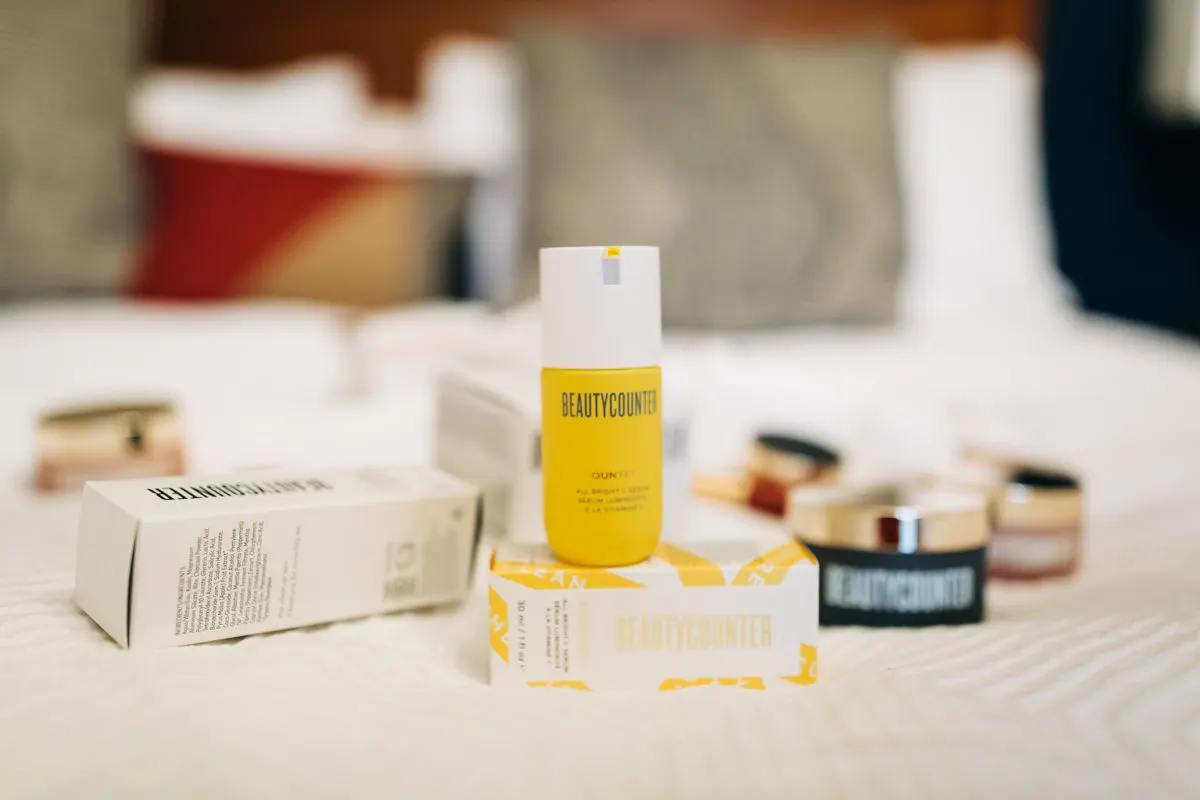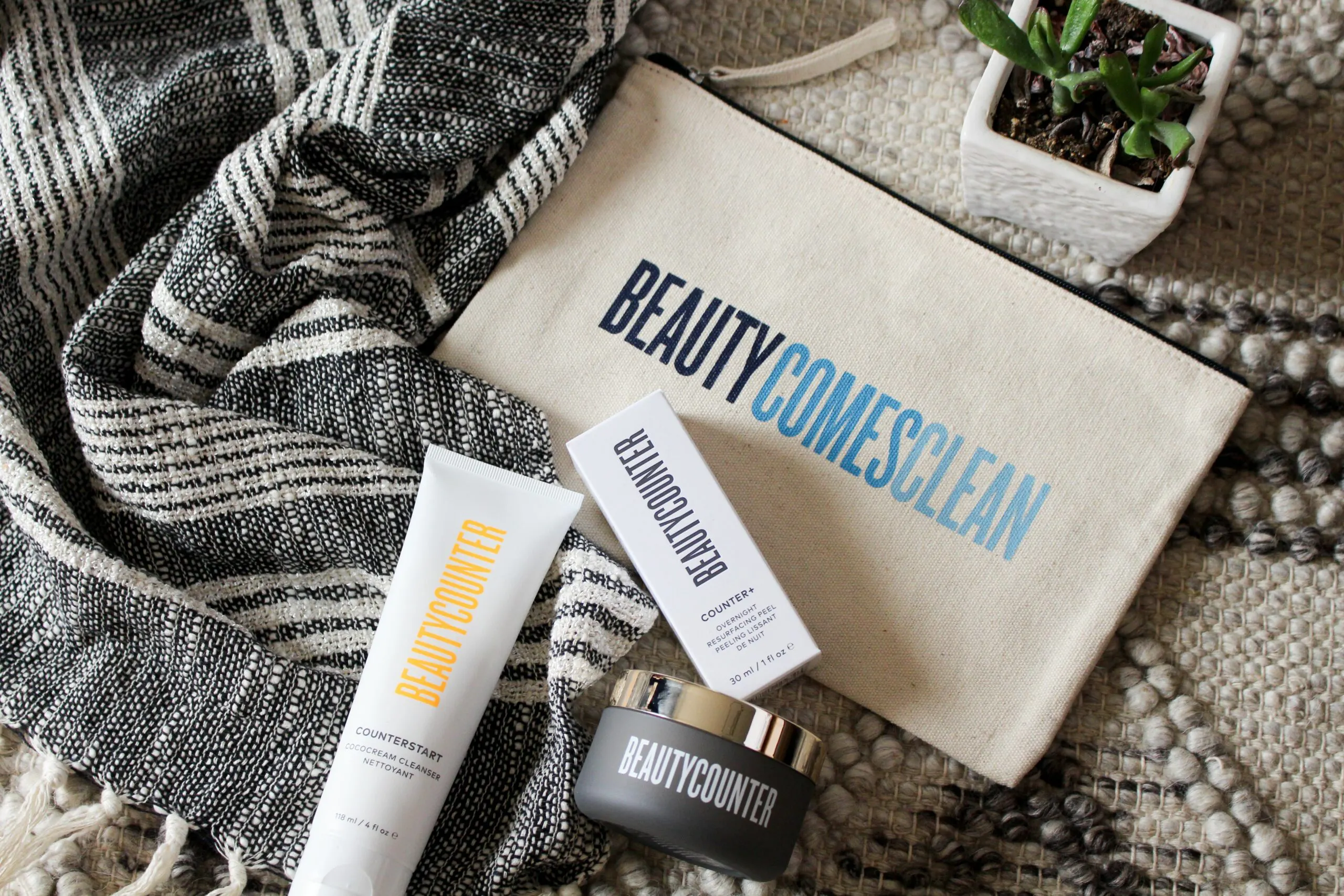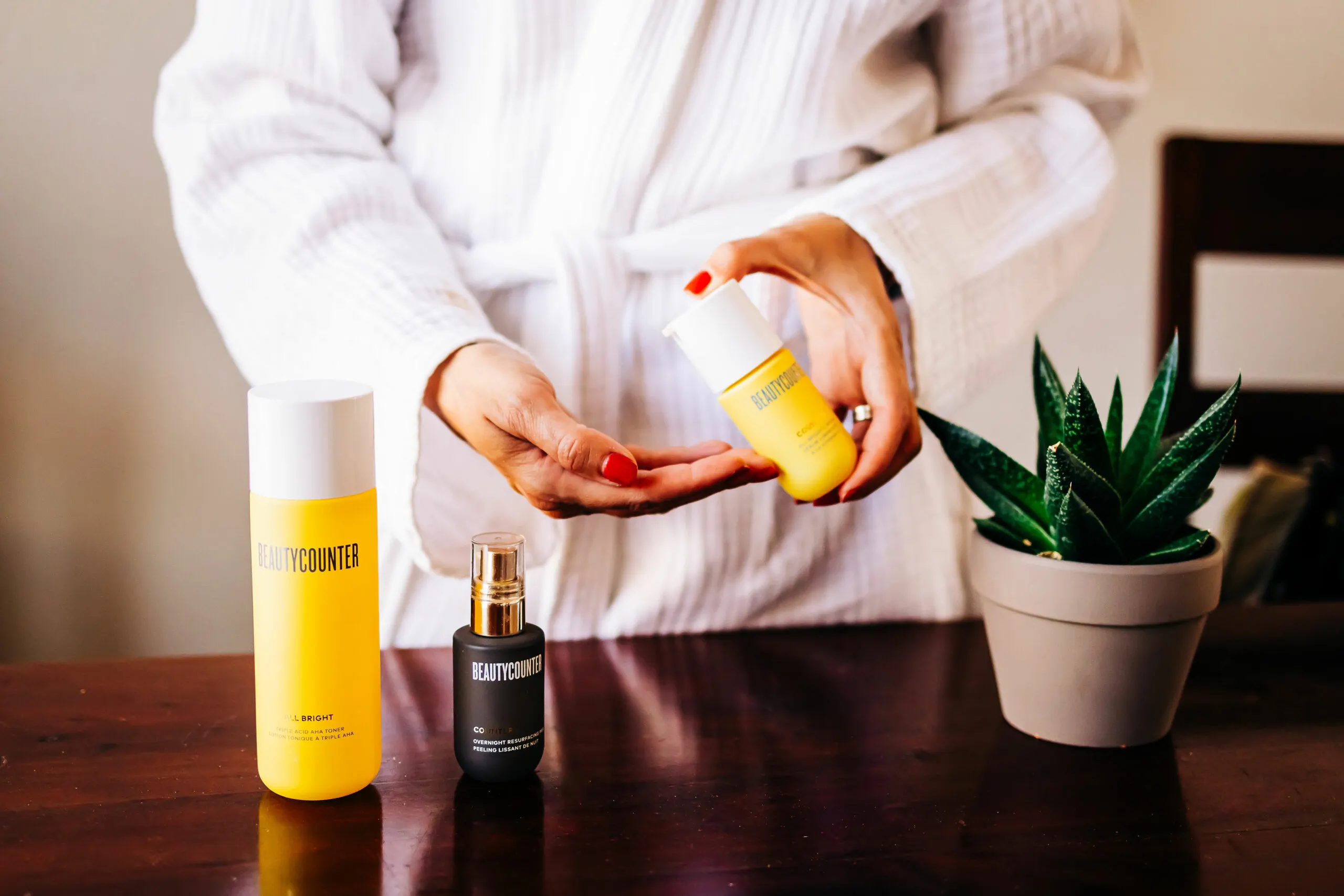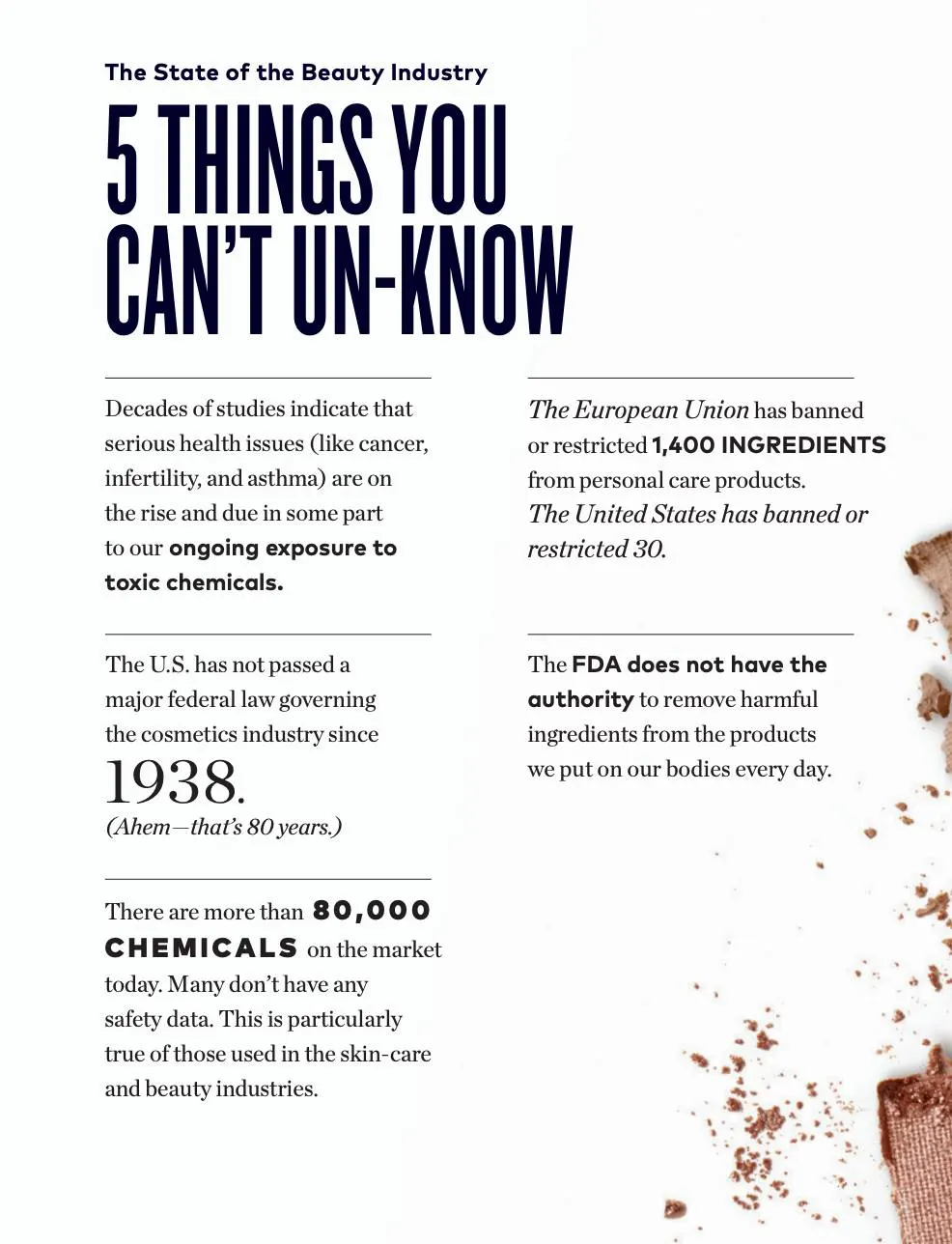Interested in switching to safer products? In this post, I’m sharing ingredients to avoid in your beauty products and why it matters for overall health.
I’ll be honest, my journey to switching to safer personal care, beauty, and skincare products began long after my health journey started. I’ve dedicated much of my life to fitness and eating well, but it wasn’t until more recently that I learned what I put ON my body matters just as much as what I put IN my body.
Lack of Regulation
Unlike the food industry, the beauty industry is unfortunately highly unregulated. The last major law regulating this multi-billion dollar industry was passed in 1938 – that’s over 80 years ago! Since then, thousands of chemicals have been introduced and companies can get away with sneaking toxic and potentially harmful ingredients into their products. Asbestos in makeup!? Scary!
My journey of switching to safer products for myself and my family and been slow and steady. I am so grateful I linked arms with Beautycounter a few years ago because it’s been an immense source of education and resources (not to mention, the community aspect and prosperous leg of my business).
As for regulating personal care products, the European Union is leading the way banning around 1,400 ingredients; Canada restricts around 600… and the United States, a measly 30! The FDA currently does not have authority to regulate what’s in our products, so it is really up to us individuals.
Once we know better, we can do better; by purchasing products with safer ingredients, we are voting with our dollar.
Ingredients To Avoid In Your Beauty Products
1. Parabens
Parabens are used in products with high water content, like shampoos, conditioners, cleansers, and moisturizers, Parabens cause endocrine disruption, which means that they can affect the delicate balance of our hormones. They mimic estrogen in the body and can alter the expression of our genes. Read more about parabens here and why they shouldn’t be in cosmetics.
2. Phthalates
Phthalates not only have a link to cancer, they’ve also been shown to contribute to a variety of health issues, including behavioral issues, asthma, breast cancer, ADHD, neurological issues, birth defects, and fertility issues. Like many harmful ingredients in cosmetics and skincare, the effects can add up.
3. Fragrance
This is a trade secret in the industry and the term “fragrance” can be used to hide upwards of 200 chemical ingredients. Companies can easily hide known neurotoxins, carcinogens, allergens, and hormone disruptors by simply calling them “fragrance.”
4. Formaldehyde
Formaldehyde is a preservative and known carcinogen. It’s frequently used as an ingredient in a variety of cosmetic products like nail polish and eyelash glue. Like many things, it can have varying effects and responses, but can cause skin irritation, eye irritation, and respiratory issues.
Unfortunately, while formaldehyde is a well-known toxic ingredient, a lot of people aren’t aware that several lesser-known cosmetics ingredients can release formaldehyde. This means that you probably won’t see “formaldehyde” listed among the ingredients in a cosmetic product because it could be listed under a different name.
Bronopol, DMDM hydantoin, quaternium-15, diazolidinyl urea, and imidazolidinyl urea are “formaldehyde releasers” found in some cosmetics. Similarly, methylene glycol, an ingredient in some hair straightening products, is formed by the reaction of formaldehyde with water. You’ll want to avoid these preservatives whenever possible.
5. Oxybenzone
Oxybenzone isn’t just an ingredient that can be harmful to us, but is harmful to the earth and our precious ecosystems. Commonly used in sunscreen, oxybenzone contributes to coral bleaching and damages the DNA of coral reefs. Hawaii was the first the ban the use of this type of sunscreen.
6. Heavy Metals
Makeup often contains heavy metals like lead, mercury and zinc. They’re used in everything from lipsticks to eyeliners—and they’re what gives them that metallic sheen.
The risks associated with heavy metals include cancer, endocrine disorders, developmental delays and neurological disorders.
Good news! Beautycounter tests each batch of their color cosmetics 3x for heavy metals.
7. Talc
Talc, usually found in dusting powders as well as powder-based makeup like eyeshadows and blushes can be conceding if it contains asbestos! Safer alternatives include starch derived from corn, maize, arrowroot, tapioca, oats or baking soda.
8. Paraffins and Petrolatum
These are long-lasting byproducts of oil refining used to make gasoline and other petroleum products… and yes, they are likely hiding in your daily body lotion. Alternative names include petroleum jelly, paraffin oil, or mineral oil – they are often snuck into lotion because of their moisturizing properties. The main health risks of paraffins and petrolatum come from improper refining processes, which can leave behind cancer-causing contaminants.
9. Resorcinol
This is an ingredient commonly found in hair dye. It can cause skin irritation, especially among people with sensitive skin. It has also been linked to immune system disfunction and thyroid disfunction.

Switch To Safer Products
Once I learned about some of the top offenders and ingredients to steer away from, it made it easier when picking out anything from shampoo and body lotion to toothpaste, deodorant and even my makeup. If I’m ever in question, I use the Environmental Working Group’s Skin Deep Database and Healthy Living App to scan products for their safety ranking.
It’s also why I choose Beautycounter time and time again; I can trust the products because of the company’s rigorous screening processes, testing, and ingredient sourcing and regulation. Beautycounter’s Never List is a growing list of over 1,800 ingredients that they exclude from all of their formulations.
Like with all aspects of wellbeing, I don’t strive for perfection — but progress. The small changes really do add up over time. I don’t think it’s realistic to completely empty out your drawers and cabinets to replace everything in one fell swoop. Instead, I’ll wait until I run out of something and use that opportunity to replace it with a safer option.
If you’re interested in making safer swaps with your products, you can fill out this quick form and I’ll email you personalized recommendations.

Cheers to safer!
xo,
Gina
You may also like:
Trending Products

FITINDEX Vibrating Foam Roller 5 Speed, Next Generation Portable 11.4×4.7“ Electric Foam Roller for Muscle Relax, Fitness Deep Massage Rechargeable Foam Roller for Yoga Exercise Post Workout, Gray

Resistance Bands for Working Out with Workout Bands Guide. 4 Booty Bands for Women Men Fabric Elastic Bands for Exercise Bands for Legs for Working Out Hip Thigh Glute Bands Set

GAODI Women Waist Trainer Vest Slim Corset Neoprene Sauna Tank Top Zipper Workout Body Shaper Shirt (L, Black Sauna Vest)

FITNE Green Tea Herbal Honey Lemon With Garcinia Senna Infusion Gentle Detox Cleanse High Antioxidant No Calories Stevia Sweetener, 15 Tea Bags

Sunny Health & Fitness Squat Assist Row-N-Ride™ Trainer for Glutes Workout with Online Training Video

FITNE Black Currant Herbal Green Tea Fruity Garcinia Senna Infusion Gentle Detox Cleansing Boost Antioxidant Wellness Tea No Calories, 15 Tea Bags











